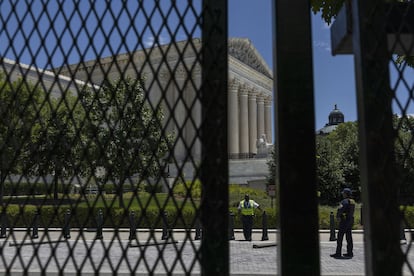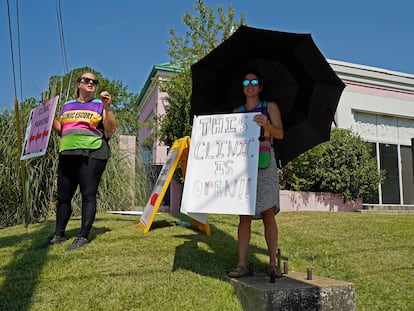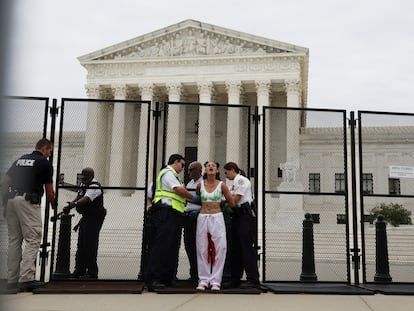The sanctuary states for abortion in the US: From California to New York
Here is an overview of how Democrat-led state governments are trying to help women following the Supreme Court’s decision to overturn ‘Roe vs Wade’


The US state of Illinois, which is surrounded by states that will likely ban abortion following the Supreme Court’s decision to overturn ‘Roe vs Wade,’ may become the destination of choice for the majority of American women who from now cannot abort in their places of origin. But it is not the only sanctuary state, California, Massachusetts, Connecticut and New York, among others, are also implementing new laws and providing funding to assist the growing number of patients.
Clinics in Illinois, California and Kansas have been preparing for this contingency for weeks. Meanwhile, the state of New York has approved, in the last legislative session prior to the summer vacations, a package of laws to protect health workers from possible lawsuits by prohibitionist states, exempting them from testifying in criminal or civil cases in places that restrict the practice. Another measure is the provision of insurance against accusations of malpractice for doctors who treat women from other states.
The Michigan and Massachusetts attorneys general have pledged not to enforce the state or federal bans, should they be approved. Lawmakers in California, where the NGO Planned Parenthood, a leading sexual healthcare service, has more than 100 clinics, have introduced more than a dozen bills to expand access to abortion, including proposals that would better fund clinics, create a $20 million state-administered fund to help patients with travel expenses, as well as allow some trained nurses to perform an abortion without a doctor’s supervision.
In the case of Illinois, it is estimated that its clinics and hospitals will see between two and five times more women than to date, the largest percentage increase in the country. Planned Parenthood, for example, has opened a logistics center in the south of the state in anticipation of the spike in patients. In the state of Kansas, Planned Parenthood calculates that the number of patients will quadruple; and has also expanded its network of centers. In California, the Democratic governor, Gavin Newson, has proposed a fund of $125 million to finance the centers that perform abortions to manage the possible influx of women from other states.
But it is not just a matter of opening more centers or providing more staff to the existing ones, but also of training primary care doctors to prescribe the abortion pill, the method used in 57% of abortions in the country. The NGO Reproductive Health Access Project has noted a “great increase” in requests among primary healthcare doctors in recent weeks, which could ease the burden on clinics and specialized centers.
The Guttmacher Institute, a reproductive health research group, expects 26 states to ban abortion now that Roe v. Wade has been overturned, not only leaving women with no options for legal abortions in their home state, but also likely limiting treatment resources in cases of miscarriage.
The leak of Judge Samuel Alito’s draft opinion a month ago, which anticipated the Supreme Court’s decision, and the recent adoption of restrictive laws such as the one in Texas have already provided a test bench of what may be to come. In Illinois, some Planned Parenthood clinics in recent weeks have been experiencing a “massive domino effect” in response to the tightened abortion restrictions in Texas, Missouri, Oklahoma and other states.
According to the Guttmacher Institute, the average cost of an abortion in the US is $550, but this does not include travel or hospitalization costs. If taken into account the figure is between $900 and $1,500, according to Planned Parenthood. Three out of four women who have an abortion are from low-income backgrounds, which is why some states have demanded more funds to care for them, especially in cases where the abortion pill is not an option because the pregnancy is too advanced. This is a problem that often affects women who live in rural areas, since they have late access to medical attention because more than half of the rural counties do not offer obstetric services, according to the National Association of Rural Health. Many of the women who are forced to travel to another state also do so against the clock. Hospital care can cost even more, although only about 4% of women who abort require hospital treatment. This occurs because their cases are too complex to be treated in outpatient clinics, where patients are discharged within a few hours. It is not the same to abort at seven weeks, a generally simple procedure, as it is to abort at 18, a process that carries greater risk for the woman, reproductive health groups point out.
To help women cover these additional expenses, Democrat-led states are calling for more funding to curb the conservative offensive. In Illinois, charities help pay for transportation, lodging and childcare for out-of-state patients, while the city of Chicago has earmarked $500,000 to help pay for those costs. In New York, State Attorney General Letitia James recently announced legislation to expand funding for clinics to help both low-income residents and those traveling from out of state. And on Friday, the governor of Massachusetts, Democrat Charlie Baker, signed an executive order to protect healthcare workers and clinics. Like New York, the executive order bars Massachusetts from cooperating with extradition attempts from other states that may pursue criminal charges in connection with receiving or performing reproductive health services that are legal in the state.
In California, the governor recently enacted a law that prohibits health insurers from charging co-pays or any other cost-sharing requirement for all abortion services. California also plans to introduce a measure to stop doctors from being prosecuted in other states for performing an abortion. Similar steps have been taken by the governor of Connecticut, Ned Lamont from the Democrat Party, to protect health workers and patients from other states and expand the list of health workers capable of legally performing an abortion.
In New York, Governor Kathy Hochul, also a Democrat, has allocated an emergency allocation of $35 million, financed by the State Department of Health, to manage the eventual influx of women from other states. Of this money, $10 million will be allocated to protecting reproductive health centers. Another bill, which has been stuck in the state Senate for months, aims to make New York taxpayers fund abortions for out-of-state women.
In some Democrat-led states, however, aid has been held up by political and legislative obstacles from the Republican opposition. Oregon, for example, which is well prepared for the possible arrival of women from Idaho, which already prohibits abortion after the sixth week, has not yet received a single dollar from a recently created relief fund.
Tu suscripción se está usando en otro dispositivo
¿Quieres añadir otro usuario a tu suscripción?
Si continúas leyendo en este dispositivo, no se podrá leer en el otro.
FlechaTu suscripción se está usando en otro dispositivo y solo puedes acceder a EL PAÍS desde un dispositivo a la vez.
Si quieres compartir tu cuenta, cambia tu suscripción a la modalidad Premium, así podrás añadir otro usuario. Cada uno accederá con su propia cuenta de email, lo que os permitirá personalizar vuestra experiencia en EL PAÍS.
¿Tienes una suscripción de empresa? Accede aquí para contratar más cuentas.
En el caso de no saber quién está usando tu cuenta, te recomendamos cambiar tu contraseña aquí.
Si decides continuar compartiendo tu cuenta, este mensaje se mostrará en tu dispositivo y en el de la otra persona que está usando tu cuenta de forma indefinida, afectando a tu experiencia de lectura. Puedes consultar aquí los términos y condiciones de la suscripción digital.
More information
Archived In
Últimas noticias
Daytime, headphones, no booze involved: How a generation is saying ‘no’ to club parties
Millennia-old Yuracaré language resists extinction through 900 speakers and a new dictionary
Susan Boyle prepares a comeback just as Timothée Chalamet sings her praises
Trump suspends green card visa lottery after shooting at Brown University
Most viewed
- Christian Louboutin: ‘Young people don’t want to be like their parents. And if their parents wear sneakers, they’re going to look for something else’
- Cartels in Mexico take a leap forward with narco-drones: ‘It is criminal groups that are leading the innovation race’
- Liset Menéndez de la Prida, neuroscientist: ‘It’s not normal to constantly seek pleasure; it’s important to be bored, to be calm’
- ‘El Limones’ and the growing union disguise of Mexican organized crime
- US sanctions against jailed cartel leader ‘El Marro’ highlight Mexico’s lack of control over its prisons










































